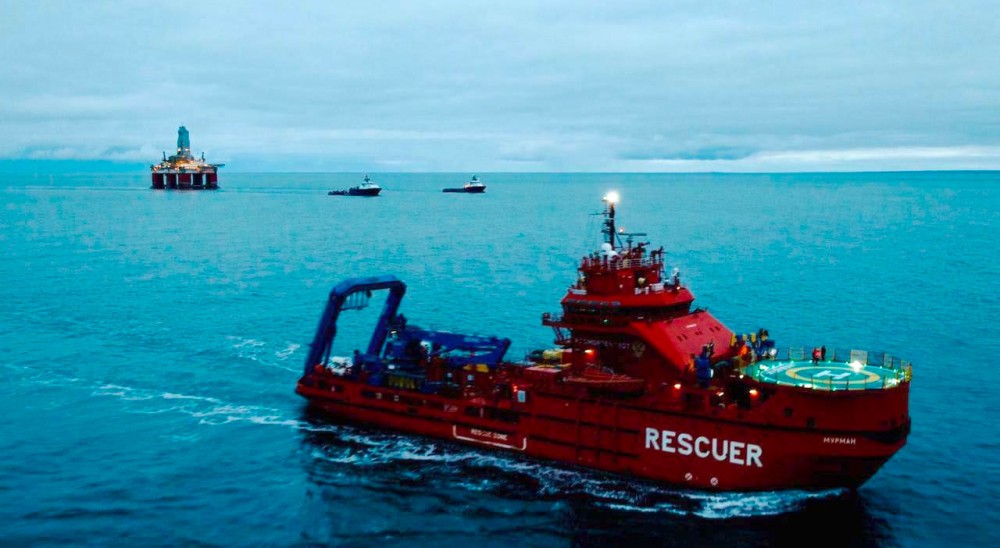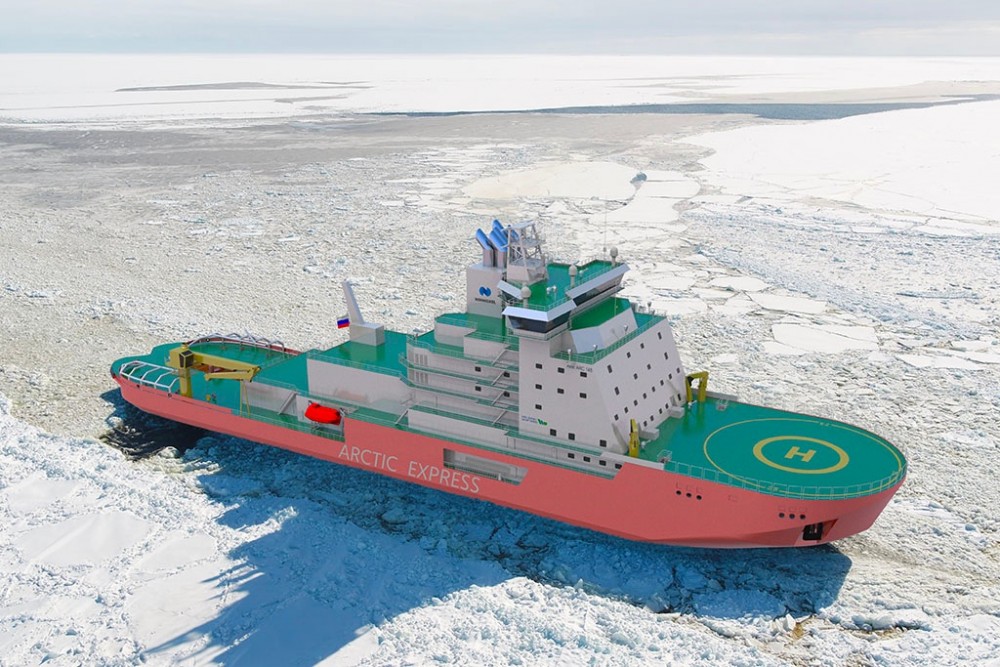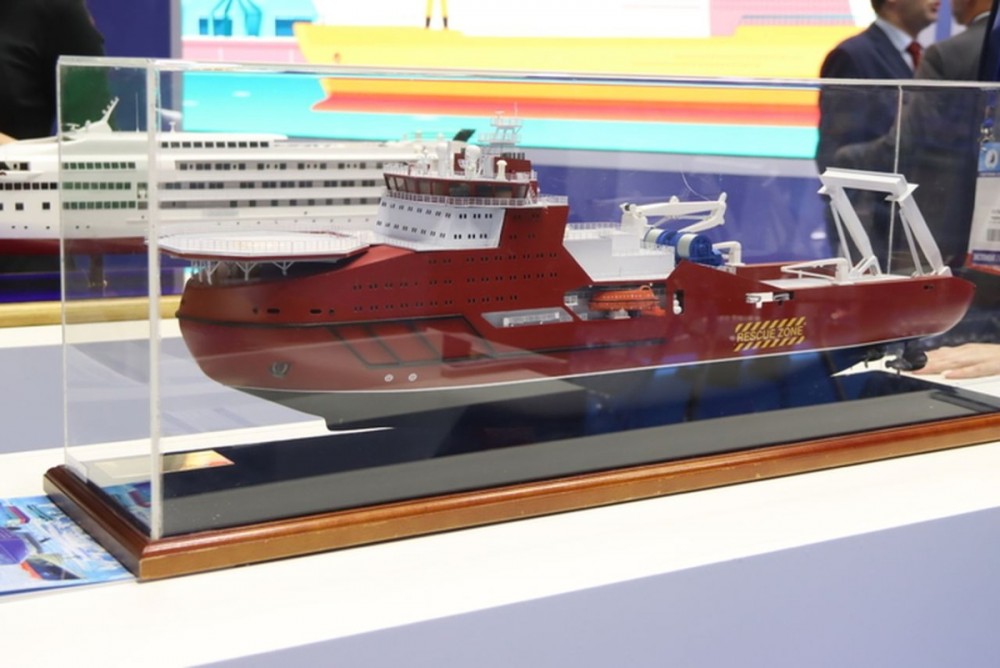UPDATED
A Russian rig prepares for drilling in the Barents Sea

The Russian natural gas monopoly is about to be kicked out of its most important markets. But the crisis notwithstanding, the company controlled by Vladimir Putin and his friends still continues to drill for additional resources.
This week, the semisubmersible Severnoye Siyanie made its way into the Barents Sea with, presumably, the Ledovoye license area as its destination.

On 29th of September, the rig reached the license area located in the central part of the Barents Sea, about 300 km west of archipelago Novaya Zemlya. Several tugs and support ships are involved in the operation, among them the Murman, Kazanin Explorer and Neptun.
The rig comes to the Barents Sea after drilling in the Kara Sea, Gazprom informs.
The Ledovoye is considered to be among Gazprom’s most prospective resources, and the company in 2021 announced its plans to drill at the structure. It is located about 70 km north of Shtokman, the field that for years was described as the world’s biggest offshore natural gas field.
Several foreign companies fought hard to get stakes in the Shtokman Development Company, and the two winners, Statoil (now Equinor) and Total, were both eager to proceed with field development until 2012 when the joint venture with Gazprom collapsed.
The Ledovoye field was long seen as an integral part of the Shtokman development.
Gazprom and its foreign partners in 2012 announced that the project development would be postponed «until better times».
A key reason for the decision was the rapid expansion of shale gas, as well as other major changes in the global gas markets.
«All parties have come to the conclusion that the financing is too high to be able to do it for the time being,» Gazprom Board Member Vsevolod Cherepanov said at a conference in Norway August 2012.
Gazprom never fully closed the door to Shtokman development, and a company program on shelf development until year 2040 includes the project as one of the priorities. The program states that the giant field in the Barents Sea is to come into production by year 2028.
Sanctions are biting on Russian
icebreaker builders

Companies Nornickel and Rosneft have scrapped plans for the building of high-tech icebreakers fueled by LNG. The vessels will instead be diesel-engined, Deputy Head of Rosatom’s Northern Sea Route Directorate Maksim Kulinko confirms.
The two companies each planned to build two powerful icebreakers fueled by LNG. But the war against Ukraine and subsequent international sanctions has led to a change of plans.
“Preliminary, we looked at the opportunity to build icebreakers fueled with LNG, but considering the sanctions and the companies’ revision of plans, both Nornickel and Rosneft confirm that they [instead] are interested in building diesel icebreakers,” Kulinko explains.
He adds that his company is “still in negotiations” with Novatek, PortNews reports.
Liquified natural gas has over the past years increasingly been seen as a prospective fuel for the powerful icebreaking vessels. Interest has grown as Novatek has developed its grand LNG plants along the Russian Arctic coast. The Yamal LNG now alone produces up to 18 million tons per year and could easily provide needed fuel for the vessels.
Rosneft, Novatek and Nornickel are all in need of enhanced icebreaker capacity as new industrial projects are under development along the remote and icy north Russian coast. The original plan was that each of the companies would build two ships operating on LNG. The two former companies would build their vessels at the new Zvezda yard in Vladivostok, while Nornickel would cooperate with the Helsinki Shipyard Oy.
Finnish company Aker Arctic has been a close partner to Nornickel and the projected 45 MW icebreakers are based on Finnish design. The ships will have ice class Arc8 and engines that can operate both on LNG and diesel fuel.
The two companies in January 2022 signed a contract on the ships that will be designed for Nornickel’s operations in the Kara Sea and Yenisey River.
However, the future of the ships might now be uncertain. According to Nornickel Vice President Sergei Dubovitsky, the construction now faces certain “limitations.”
Nuclear-powered multipurpose ship for Arctic operations presented

After Rosatom in 2019 officially was granted the leading role in development of Russia’s Arctic region, projects involving nuclear power are presented time and again.
Rosatom is Russia’s state nuclear corporation.
At this week’s shipping and offshore congress in St. Petersburg, the Iceberg Central Design Bureau presented its latest proposal. A multipurpose icebreaking vessel to be powered by the RITM-200 reactors.
This is the same reactor plant used onboard the new icebreakers of Project 22220, of which the “Arktika” and “Sibir” are delivered, while “Ural”, “Kamchatka” and “Yakutia” are under construction.
The new vessel design could be used for six different modifications, like shallow-water icebreaker, supply vessel to drilling platforms, rescue operations in ice-covered waters, or other tasks in Arctic waters.
Design name is Project 10570 and the vessel is 152 meters long, 31 meters wide and has a draft of up to 9,3 meters,
With the powerful reactors, navigation can take place in ice up to 2,4 meters thick, the design bureau informs. It was the shipping online Sudostoenie Info that first reported about the vessel.
No comments:
Post a Comment